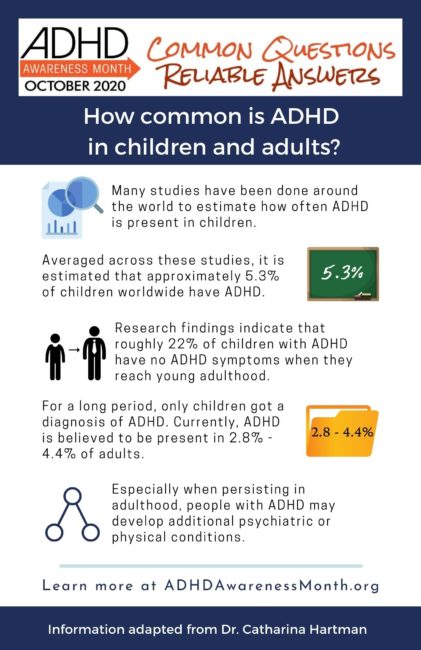The behaviors that characterize ADHD were described a long time ago, but in clinical practice the diagnosis of ADHD has been used for only 40 years. This was also when ADHD became important in scientific research. Since then many studies have been done around the world to estimate how often ADHD is present in children. Averaged across these studies it has been estimated that around 5.6%, i.e., roughly one in every twenty children, has ADHD. Around the age of 12 years old and further on during adolescence, some of the children with ADHD start to experience fewer symptoms of ADHD. Research findings indicate that by young adulthood, roughly 22% of children have no ADHD symptoms anymore, 43% still have symptoms and impairments in daily life although not as severe as before, and another 35% still have the symptoms and impairments as they had these during childhood.
For a long time, only children received a diagnosis of ADHD. When it became clear that only a minority of the children ‘lost’ their symptoms and impairments when they reached adulthood, researchers started to investigate how often it was the case that symptoms and impairments remained so severe that the ADHD diagnosis applies. The current best estimate is that ADHD is present between 2.8% to 4.4% of adults. Especially when persisting in adulthood, persons with ADHD may develop additional psychiatric or somatic conditions that have their onset in adulthood, like depression or diabetes. These conditions are more frequent in adults with ADHD compared to adults without ADHD and could potentially be prevented if ADHD could be successfully treated. However, the latter is speculative; this has not yet been fully established by sound scientific research. In addition, there are still very few longitudinal studies examining how ADHD develops during adulthood.
About the Author

Catharina Hartman is an associate professor of psychiatric epidemiology in the Netherlands. Her research is focused on improving our understanding of childhood-onset psychiatric disorders and their course across the lifespan, in particular ADHD and autism.
Further Reading
Lange KW, Reichl S, Lange KM, Tucha L, Tucha O. The history of attention deficit hyperactivity disorder. Atten Defic Hyperact Disord. 2010; 2(4):241–55. https://www.ncbi.nlm.nih.gov/pmc/articles/PMC3000907/
Polanczyk G, de Lima MS, Horta BL, Biederman J, Rohde LA. The worldwide prevalence of ADHD: a systematic review and metaregression analysis. Am J Psychiatry. 2007; 164(6):942-948. doi:10.1176/ajp.2007.164.6.942 https://ajp.psychiatryonline.org/doi/10.1176/ajp.2007.164.6.942
Fayyad J, Sampson NA, Hwang I, et al. The descriptive epidemiology of DSM-IV Adult ADHD in the World Health Organization World Mental Health Surveys. Atten Defic Hyperact Disord. 2017; 9(1):47-65. doi:10.1007/s12402-016-0208-3 https://www.ncbi.nlm.nih.gov/pmc/articles/PMC5325787/
Kessler RC, Adler L, Barkley R, et al. The prevalence and correlates of adult ADHD in the United States: results from the National Comorbidity Survey Replication. Am J Psychiatry 2006; 163:716–23. https://www.ncbi.nlm.nih.gov/pmc/articles/PMC2859678/
Franke B, Michelini G, Asherson P, Banaschewski T, Bilbow A, Buitelaar JK, Cormand B, Faraone SV, Ginsberg Y, Haavik J, Kuntsi J, Larsson H, Lesch KP, Ramos-Quiroga JA, Réthelyi JM, Ribases M, Reif A. Live fast, die young? A review on the developmental trajectories of ADHD across the lifespan. Eur Neuropsychopharmacol. 2018 Oct;28(10):1059-1088. doi: 10.1016/j.euroneuro.2018.08.001. https://www.ncbi.nlm.nih.gov/pmc/articles/PMC6379245/

